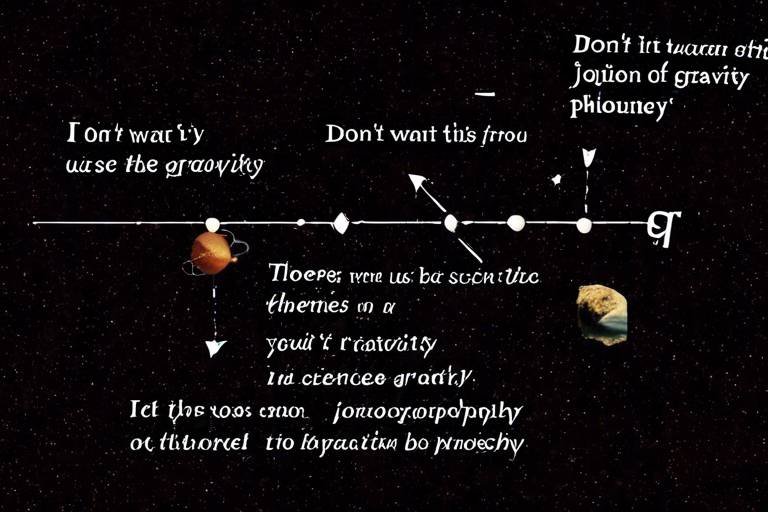Is the Universe Fine-Tuned for Life?
Have you ever gazed up at the stars and wondered how it all came to be? The vastness of the universe can be both awe-inspiring and perplexing. One of the most intriguing concepts that arises in this context is the idea of fine-tuning. This notion suggests that the universe is not just a random collection of matter and energy, but rather a meticulously crafted environment that seems to be perfectly suited for the existence of life. It’s almost as if the universe has been designed with us in mind! But what does this really mean, and how do we know that our universe is, in fact, fine-tuned for life?
At the heart of the fine-tuning argument lies the observation that certain fundamental constants and conditions in the universe appear to be set at just the right values to allow life to flourish. Imagine a cosmic recipe where every ingredient must be measured precisely—too much or too little of any one element, and the dish could turn out disastrous. In this case, the "dish" is our universe, and the ingredients include forces like gravity and electromagnetism, as well as the laws of physics that govern their interactions.
So, why is this important? If the universe is indeed fine-tuned, it raises profound questions about our existence. Are we here by mere chance, or is there a deeper purpose behind the universe's structure? In the following sections, we will explore the concept of fine-tuning in greater detail, examining key constants and conditions that contribute to life, as well as the philosophical implications of our findings. Buckle up, as we embark on a journey through the cosmos that might just change the way you view your place in it!

The Concept of Fine-Tuning
When we talk about the universe being fine-tuned, we're diving into a fascinating and somewhat mind-boggling concept. Imagine a giant cosmic dial with various settings that need to be adjusted just right for life to exist. Fine-tuning refers to the incredibly precise conditions and fundamental constants that govern our universe, allowing for the complex tapestry of life we see today. It's like baking a cake; if you don’t get the measurements just right, you’ll end up with a flat disaster instead of a delicious treat!
At its core, fine-tuning suggests that the universe's physical laws and constants are not just random; rather, they appear to be set in a way that supports the existence of life. This raises some intriguing questions: Is our universe a rare gem in a vast cosmos, or are there countless other universes out there, each with different settings? The significance of fine-tuning goes beyond mere curiosity; it touches on profound philosophical and scientific implications. What does it mean for our understanding of existence, and how do we reconcile the apparent odds against life with the reality that we are here?
Some of the key constants that are often discussed in the context of fine-tuning include:
- The Gravitational Constant: Determines the strength of gravity.
- The Electromagnetic Force: Governs the interactions between charged particles.
- The Strong and Weak Nuclear Forces: Essential for the stability of atoms.
- The Cosmological Constant: Affects the expansion of the universe.
These constants are like the ingredients in our cosmic cake, and if they were even slightly different, the universe as we know it might not exist. For example, if the gravitational force were significantly stronger, stars would burn out too quickly, and life as we know it would never have had a chance to develop. Conversely, if it were weaker, stars might not form at all. The delicate balance of these forces creates a unique environment conducive to life, leading many to ponder whether this fine-tuning is merely a cosmic coincidence or indicative of something more.
In summary, the concept of fine-tuning invites us to explore the universe's intricate design and the possibility that our existence is far from accidental. It challenges us to think deeply about the nature of reality and our place within this vast cosmos. As we continue to unravel the mysteries of the universe, the question remains: Are we truly alone in our finely-tuned bubble, or is there a grander scheme at play?

Key Constants and Conditions
When we talk about the universe being fine-tuned for life, we’re diving into some seriously fascinating territory! The idea hinges on a few key constants and conditions that seem almost tailor-made for the existence of life as we know it. Think of the universe as a complex recipe; just like baking a cake requires the right mix of ingredients in precise amounts, the universe needs specific constants to create the conditions that support life. If even one of these constants were slightly different, who knows what kind of universe we’d be living in—or if we’d exist at all!
Among the most critical constants are the gravitational force, the electromagnetic force, and the strong nuclear force. Each of these plays a pivotal role in shaping the cosmos and the life within it. Let’s break down a few of these constants and their significance:
| Constant | Value | Significance |
|---|---|---|
| Gravitational Constant (G) | 6.674 × 10-11 N(m/kg)2 | Determines the strength of gravity, essential for star and planet formation. |
| Electromagnetic Constant (α) | 1/137 | Governs the strength of electromagnetic interactions, crucial for chemical reactions. |
| Strong Nuclear Force Constant | Varies | Binds protons and neutrons in atomic nuclei, essential for the formation of matter. |
These constants are not just numbers; they are the very fabric of reality. For instance, if the gravitational constant were even slightly stronger, stars would burn out much faster, making it nearly impossible for life to evolve. Conversely, if it were weaker, stars might not form at all, leaving the universe a cold, dark place devoid of life. Isn’t that mind-blowing?
Then we have the electromagnetic force, which is responsible for the interactions between charged particles. This force is what allows atoms to bond and form the complex molecules necessary for life. Imagine trying to build a house without the right tools; that’s what it would be like without the electromagnetic force! Without it, the very building blocks of life—like DNA and proteins—would struggle to exist.
In addition to these constants, there are other conditions, such as the density of matter and the expansion rate of the universe, that also play a crucial role in determining whether or not life can thrive. The delicate balance of these factors creates a universe that is not just capable of supporting life but seems to be designed for it.
As we ponder these constants and conditions, we can’t help but wonder: are we just lucky, or is there something more profound at play? The universe feels like a finely tuned instrument, and we’re lucky enough to be part of the orchestra! So, the next time you gaze up at the stars, remember that the universe has crafted a stage just for you, with all the right elements to support life in this vast cosmic symphony.

The Role of Gravity
Gravity is not just a force; it's the very fabric that weaves the universe together. Imagine the universe as a grand stage, with gravity as the invisible puppeteer, orchestrating the dance of celestial bodies. Without this fundamental force, stars would never ignite, planets wouldn’t form, and life as we know it would simply not exist. Gravity is responsible for the formation of galaxies, stars, and planets, creating the conditions that allow life to flourish.
When we think about gravity, we often picture it as a simple pull that keeps us grounded on Earth. However, its influence stretches far beyond our planet. It dictates the orbits of planets around stars, the behavior of galaxies, and the structure of the universe itself. The strength of gravity affects how stars are born and die, and ultimately, how they provide the essential elements for life. If gravity were even slightly weaker or stronger, the universe would look dramatically different. For instance, if gravity were weaker, stars would burn out too quickly, leaving insufficient time for complex life to evolve. Conversely, if gravity were stronger, stars might burn too hot and fast, leading to a universe devoid of stable planetary systems.
Let’s break down the critical ways gravity influences the cosmos:
- Star Formation: Gravity pulls together clouds of gas and dust, leading to the birth of stars. This process is crucial because stars are the engines of the universe, producing energy through nuclear fusion.
- Planetary Development: Once a star forms, its gravitational pull helps in gathering surrounding material, leading to the creation of planets. The right balance of gravity ensures that these planets can maintain stable orbits, which is vital for developing ecosystems.
- Habitable Zones: The gravitational force of a star determines the habitable zone, or the "Goldilocks zone," where conditions are just right for liquid water to exist, a key ingredient for life.
Gravity also plays a pivotal role in the life cycles of stars. As stars age, they undergo transformations that can lead to the creation of heavier elements through processes like supernova explosions. These explosions scatter elements across the universe, enriching the cosmic environment and providing the building blocks for planets and, eventually, life. This cycle of birth, death, and rebirth of stars is a testament to the intricate balance that gravity maintains in the universe.
In summary, gravity is not merely a force; it is a fundamental architect of the universe. Its delicate balance creates the conditions necessary for the formation of stars, planets, and ultimately, life itself. Without gravity, the universe would be an entirely different place, and our existence would be nothing but a distant dream. So, the next time you look up at the night sky, remember that gravity is the silent force that makes it all possible.
- What is gravity? Gravity is a natural phenomenon by which all things with mass or energy are brought toward one another, including planets, stars, galaxies, and even light.
- How does gravity affect star formation? Gravity pulls together gas and dust in space, leading to the collapse of these materials into dense regions that eventually form stars.
- Can gravity be altered? Gravity itself cannot be altered, but its effects can be influenced by the mass and distance between objects.

Gravity's Influence on Stars
Gravity is not just a force; it's the very architect of the universe, sculpting the celestial bodies that fill the night sky. When we gaze up at the stars, we are witnessing the fruits of gravity's relentless pull. Imagine gravity as a cosmic glue that binds together the clouds of gas and dust in space, allowing them to coalesce and form stars. Without this gravitational force, those swirling clouds would drift aimlessly, and the stars that illuminate our skies would never come into existence.
The process of star formation begins in regions of space known as molecular clouds, which are dense and cold collections of gas and dust. Here, gravity plays a pivotal role by pulling these particles together. As they clump, the gravitational force increases, leading to a process known as gravitational collapse. This collapse generates heat, and once the temperature rises sufficiently, nuclear fusion ignites, giving birth to a star. It's a beautiful cosmic dance, one that highlights how crucial gravity is in the grand tapestry of the universe.
To illustrate this, consider the following stages of star formation:
| Stage | Description |
|---|---|
| Molecular Cloud | A cold, dense region where gas and dust accumulate. |
| Gravitational Collapse | Particles within the cloud begin to clump together due to gravity. |
| Protostar Formation | As clumping continues, a protostar forms at the center. |
| Nuclear Fusion | Temperature rises, igniting fusion and creating a new star. |
Once stars are formed, gravity continues to play a critical role in their evolution and lifecycle. It governs the balance between the outward pressure created by nuclear fusion and the inward pull of gravity itself. This balance is what keeps stars stable for billions of years. If gravity were slightly weaker, stars would burn through their fuel too quickly, leading to a universe devoid of long-lived stars. Conversely, if gravity were stronger, stars could become so massive that they would end their lives in spectacular explosions known as supernovae, scattering their elements throughout the cosmos.
Moreover, gravity is essential for the formation of planetary systems. As stars form, their gravitational pull influences surrounding material, leading to the creation of planets, moons, and other celestial bodies. This gravitational interaction is what helps maintain the stability of these systems, allowing planets to orbit their stars in a predictable manner. Without gravity, the intricate dance of celestial mechanics that allows for the existence of life-supporting planets would fall apart.
In summary, gravity is the silent yet powerful force that shapes the stars and, consequently, the universe we inhabit. It is the reason we have stars that can provide the energy necessary for life to thrive on planets like Earth. Understanding gravity's influence on stars not only sheds light on the formation of our universe but also emphasizes the delicate balance required for life to exist. So, the next time you look up at the stars, remember that gravity is the unseen hand guiding the cosmic ballet above us.
- What is the role of gravity in star formation? Gravity pulls together gas and dust in molecular clouds, leading to the creation of stars.
- How does gravity affect the lifecycle of a star? Gravity maintains the balance between nuclear fusion's outward pressure and the inward pull, ensuring stars remain stable.
- Can stars exist without gravity? No, gravity is essential for star formation and stability; without it, stars wouldn't form at all.

Planetary Formation and Stability
The formation of planets is a fascinating process that occurs over millions of years, influenced by a variety of cosmic factors. To understand how planetary systems develop and maintain stability, we need to delve into the intricate dance of gravitational forces, dust, gas, and the remnants of stars. Imagine a bustling cosmic kitchen where ingredients are swirling around, waiting for the right conditions to create something extraordinary—our planets!
Initially, a cloud of gas and dust, known as a solar nebula, begins to collapse under its own gravity. As it contracts, it spins faster, much like a figure skater pulling in their arms to spin more quickly. This rotation leads to the formation of a disk where most of the material gathers in the center, eventually forming a star. The remaining material in the disk starts to coalesce into smaller clumps, which over time, grow larger as they collide and merge. This process is known as accretion.
As these clumps grow into protoplanets, their gravitational pull becomes significant enough to attract more material. However, not all protoplanets will become planets; some may collide and create larger bodies, while others may be ejected from the system altogether. The gravitational interactions among these bodies are crucial for determining which ones will remain stable in their orbits. It’s like a game of cosmic musical chairs, where only the most stable players get to keep their seats!
Once a planet forms, its stability is influenced by several factors, including its distance from the star, its mass, and the presence of other celestial bodies. For instance, a planet that is too close to its star may experience extreme temperatures that could strip away its atmosphere, while one that is too far may be too cold to support life. The Goldilocks Zone, or habitable zone, is the region around a star where conditions are just right for liquid water to exist—a crucial ingredient for life as we know it.
Moreover, the gravitational interactions among planets can lead to a phenomenon known as orbital resonance, where two orbiting bodies exert regular, periodic gravitational influence on each other. This can stabilize their orbits, allowing them to coexist without colliding. For example, the relationship between Jupiter and its moons showcases how larger bodies can help maintain the stability of smaller ones. The gravitational pull of Jupiter keeps its moons in stable orbits, preventing them from drifting away or crashing into one another.
In summary, planetary formation and stability are the results of a complex interplay of gravitational forces and cosmic materials. Without the right conditions, planets may never form, or they may find themselves in unstable orbits, unable to support life. Understanding this process not only sheds light on our own solar system but also on the potential for life elsewhere in the universe. As we continue to explore distant exoplanets, we are left to wonder: how many other worlds are out there, perfectly positioned in their own Goldilocks Zones, waiting for discovery?
- What is the Goldilocks Zone? The Goldilocks Zone is the habitable zone around a star where conditions are just right for liquid water to exist, making it possible for life to thrive.
- How do planets maintain stability in their orbits? Planets maintain stability through gravitational interactions with their star and other celestial bodies, which help to keep them in predictable orbits.
- What role does gravity play in planetary formation? Gravity is the driving force that causes gas and dust in a solar nebula to collapse and form planets, as well as the force that governs their movements and interactions.

The Electromagnetic Force
The electromagnetic force is one of the four fundamental forces of nature, and it plays a pivotal role in the universe as we know it. It governs the interactions between charged particles, which is crucial for the formation of atoms and molecules. Without this force, the very building blocks of matter would not hold together, and life, as we understand it, would simply not exist. Imagine trying to build a house without bricks; that’s what it would be like without the electromagnetic force holding atoms together!
This force is responsible for a wide range of phenomena, from the light we see to the chemical reactions that sustain life. For instance, when you turn on a light bulb, it is the electromagnetic force that allows electrons to flow through the wires, producing light. This is not just a trivial detail; it's a fundamental aspect of how energy and matter interact in our universe. The ability of atoms to bond and form complex structures is a direct result of electromagnetic interactions, which are essential for creating the molecules that make up living organisms.
To better understand the significance of the electromagnetic force, let’s look at a few key points:
- Chemical Reactions: The electromagnetic force facilitates chemical bonds, enabling the formation of molecules like DNA and proteins, which are vital for life.
- Stability of Matter: It provides the necessary attraction between electrons and protons, ensuring that atoms remain stable.
- Energy Transfer: Electromagnetic interactions allow for the transfer of energy, whether it's through the absorption of light by plants during photosynthesis or the way our bodies metabolize food.
Moreover, the electromagnetic force is not just about attraction; it also involves repulsion. Like charges repel each other, which is crucial for the structure of matter. If protons in the nucleus of an atom didn't repel each other, atoms would collapse under their own weight. This delicate balance of attraction and repulsion creates a universe that is not only stable but also rich in diversity.
In summary, the electromagnetic force is a cornerstone of life and the universe itself. It shapes the interactions between particles, forms the basis of chemistry, and ultimately enables the complexity of life. Without it, the universe would be a vastly different place, possibly devoid of the intricate systems we see today. Understanding this force helps us appreciate the fine-tuning of our universe, which seems perfectly designed to support life.
- What is the electromagnetic force? The electromagnetic force is one of the four fundamental forces in nature that governs the interactions between charged particles.
- Why is the electromagnetic force important for life? It is crucial for the formation of atoms and molecules, enabling chemical reactions that sustain life.
- How does the electromagnetic force affect matter? It provides the attraction between electrons and protons, ensuring atomic stability and allowing for the formation of complex molecules.

Anthropic Principle
The is a fascinating concept that attempts to explain why the universe appears to be finely tuned for the existence of life. At its core, this principle suggests that the fundamental parameters of our universe are not just random; they are conditioned by the very existence of observers like us. It's almost as if the universe is a stage, and we are the actors carefully placed in a script that allows for life to flourish. But what does this really mean? Let's dive deeper into its implications and interpretations.
The anthropic principle can be divided into two main interpretations: the weak anthropic principle and the strong anthropic principle. Each perspective offers a unique lens through which we can view our existence and the universe's characteristics.
The weak anthropic principle posits that we can only observe the universe's conditions because those conditions allow for our existence. In simpler terms, if the universe were different—say, with different physical constants—we might not be here to ponder these questions at all. This perspective shapes our understanding of fine-tuning by implying that the universe's specific characteristics are a result of a selection effect. Just like a lottery winner can only reflect on their luck because they won, we can only reflect on the universe's life-supporting features because we exist within it.
On the flip side, the strong anthropic principle argues that the universe must possess properties that ensure life exists. This viewpoint raises intriguing philosophical questions about the nature of reality. Is it possible that the universe was designed with us in mind? This idea can be both exhilarating and unsettling. It suggests that the cosmos might be more than just a random collection of particles and forces; perhaps it is a grand tapestry woven with intention. This interpretation invites us to consider the possibility that the universe is not just a backdrop for life, but an active participant in the drama of existence.
Both interpretations of the anthropic principle challenge our understanding of the universe and our place within it. They prompt us to ask profound questions:
- Are we merely lucky observers in a vast cosmos, or is there a deeper purpose behind the universe's design?
- Does the existence of life in the universe imply some form of intentionality behind its creation?
Ultimately, the anthropic principle serves as a bridge between science and philosophy, inviting us to ponder the very fabric of reality. It encourages us to explore not only the mechanics of the universe but also the meaning behind our existence. As we continue to unravel the mysteries of the cosmos, the anthropic principle reminds us that we are not just passive observers; we are an integral part of this grand cosmic story.

Weak Anthropic Principle
The offers a fascinating lens through which we can view the universe and our place within it. At its core, this principle posits that the universe's conditions appear fine-tuned for life simply because we are here to observe them. It suggests that if the universe had different properties, we wouldn’t exist to ponder these questions. Imagine walking into a tailor shop and marveling at a perfectly fitted suit; it seems designed just for you, but the reality is, it’s tailored from a variety of options, and you happened to choose the right one. Similarly, the universe's parameters might seem ideal for life, but they are just a fraction of what could exist.
This principle raises intriguing questions about existence. For instance, if the gravitational constant were slightly different, stars might not form as they do, leading to a universe devoid of life. The weak anthropic principle doesn’t claim that the universe was designed with life in mind; rather, it implies that our existence is a product of a universe that, against all odds, allows for life to flourish. It’s a comforting thought—our very existence is a testament to the universe's remarkable conditions.
To illustrate this further, consider the following key points about the weak anthropic principle:
- Observer-Dependent Conditions: The universe's properties are observed through the lens of life; hence, they must permit our existence.
- Selection Bias: We only notice the universe's life-supporting features because we are here to notice them.
- Philosophical Implications: It challenges the notion of a designed universe, suggesting a more random, albeit fortunate, set of circumstances.
Critics of the weak anthropic principle argue that it can lead to a form of intellectual complacency, where we might accept the universe as it is without delving deeper into the underlying mechanisms that govern it. However, supporters believe it serves as a vital reminder of our unique position in the cosmos, encouraging us to explore further. The principle does not negate the possibility of a designed universe; instead, it opens the door to a broader understanding of why we find ourselves in such a remarkable place.
In summary, the weak anthropic principle provides a framework for understanding why we perceive the universe as being fine-tuned for life. It emphasizes that our existence is not just a happy accident but a reflection of the universe's unique conditions that allow us to thrive. As we continue to explore the cosmos, this principle invites us to ponder not just our existence but the very nature of the universe itself.
- What is the weak anthropic principle? The weak anthropic principle suggests that the universe's conditions are observed to be life-supporting because we exist to observe them.
- How does the weak anthropic principle differ from the strong anthropic principle? The weak anthropic principle states that we observe the universe as it is because it allows for our existence, while the strong anthropic principle suggests that the universe must have properties that ensure life exists.
- What are some implications of the weak anthropic principle? It challenges the notion of a designed universe and emphasizes the randomness of our existence while still acknowledging the remarkable conditions that allow for life.

Strong Anthropic Principle
The is a fascinating concept that delves deep into the very fabric of our universe and our existence within it. Unlike its weaker counterpart, which merely suggests that we observe the universe under conditions that permit our survival, the strong version takes a more assertive stance. It posits that the universe must possess certain properties that inevitably lead to the emergence of life. This idea raises profound questions about the nature of reality and our place in it.
Imagine for a moment that the universe is a grand stage, and we are the actors. The strong anthropic principle suggests that the script was written with us in mind, that the cosmic conditions were set to ensure that life would not just be a fleeting possibility, but a necessary outcome. This perspective invites us to ponder why the fundamental parameters of our universe—such as the strength of the forces of nature and the values of various constants—are precisely what they need to be for life to flourish.
To grasp the implications of this principle, consider the following key points:
- Life as a Cosmic Imperative: The strong anthropic principle implies that the universe is structured in such a way that life is not just a byproduct but a fundamental outcome of its laws.
- Fine-Tuning and Design: This principle often leads to discussions about the potential for a designer or an intelligent force behind the universe, as it seems to suggest that the universe is tailored for life.
- Philosophical Implications: It challenges our understanding of existence and raises questions about purpose and meaning in the cosmos. Are we merely lucky, or is there a deeper intention behind our existence?
Critics of the strong anthropic principle argue that it can lead to a form of cosmic narcissism, where humanity places itself at the center of the universe's narrative. They contend that while it is a compelling idea, it may not necessarily reflect the true nature of reality. However, proponents maintain that the alignment of so many factors to support life is too significant to dismiss as mere coincidence.
In essence, the strong anthropic principle not only enriches our understanding of the universe but also invites us to reflect on our role within it. It challenges us to consider whether we are here by mere chance or if our existence is woven into the very tapestry of cosmic history. As we explore the universe, we may find that the answers to these profound questions are as complex as the cosmos itself.
- What is the strong anthropic principle? The strong anthropic principle suggests that the universe must have properties that ensure the existence of life, implying a purposeful design in its structure.
- How does the strong anthropic principle differ from the weak anthropic principle? The weak anthropic principle states that we can observe the universe's conditions because they allow for our existence, while the strong version asserts that the universe is inherently designed to support life.
- What are the implications of the strong anthropic principle? It raises questions about the purpose of the universe, the possibility of a designer, and challenges our understanding of existence and reality.

Counterarguments to Fine-Tuning
While the concept of fine-tuning presents a fascinating argument for a universe designed for life, it’s essential to explore the counterarguments that challenge this perspective. One of the most significant critiques comes from the realm of multiverse theory. This theory posits that our universe is just one of many, each with its own set of physical constants and laws. Imagine a vast cosmic lottery where every possible combination of physical laws exists. In this scenario, it’s not surprising that we find ourselves in a universe that seems finely tuned for life; we simply happen to be in the one that supports our existence.
Another compelling counterargument is the notion of naturalistic explanations. This perspective suggests that life might not be as picky as we once thought. Instead of requiring a precise set of conditions, life could emerge under a broader range of circumstances. For instance, extremophiles—organisms that thrive in extreme environments—demonstrate that life can adapt to conditions previously deemed inhospitable. This adaptability raises questions about the necessity of fine-tuning, suggesting that life could arise in various environments across different cosmic settings.
Moreover, some scientists argue that our understanding of the universe is still incomplete. As we continue to explore and gather data, we may discover new principles that could explain the apparent fine-tuning without invoking design. For example, certain theories in physics, like string theory, propose mechanisms that could naturally lead to the conditions we observe in our universe. It’s akin to peeling back the layers of an onion; each layer reveals more complexity and potentially simpler explanations for what we perceive as fine-tuning.
To further illustrate these counterarguments, let’s delve into a
| Counterargument | Description |
|---|---|
| Multiverse Theory | Proposes the existence of multiple universes with varying constants, suggesting we are in one that supports life. |
| Naturalistic Explanations | Life may emerge under a broader range of conditions than previously thought, as shown by extremophiles. |
| Incomplete Understanding | Our current knowledge of the universe may be limited, and future discoveries could provide natural explanations for fine-tuning. |
In conclusion, while the fine-tuning argument is compelling, it’s crucial to consider these counterarguments. They not only challenge the notion of a designed universe but also open up exciting avenues for further exploration into the nature of existence itself. As we continue to investigate, the universe may reveal its secrets, leading us to a deeper understanding of our place within it.
- What is fine-tuning? Fine-tuning refers to the precise conditions and constants in the universe that allow for the existence of life.
- What is multiverse theory? Multiverse theory suggests that there are multiple universes, each with different physical laws and constants.
- How does naturalistic explanation challenge fine-tuning? It suggests that life can arise under a wider range of conditions than previously believed, reducing the necessity for fine-tuning.
- What are extremophiles? Extremophiles are organisms that thrive in extreme environments, demonstrating the adaptability of life.

Multiverse Theory
The is a fascinating and somewhat mind-bending concept that suggests our universe is just one of many that exist simultaneously. Imagine a vast sea of universes, each with its own set of physical laws, constants, and conditions. This theory challenges the notion of fine-tuning by proposing that if there are indeed countless universes, each with different parameters, then it’s not surprising that one of them—ours—happens to support life.
One of the most intriguing aspects of the multiverse theory is the idea that these universes could have wildly varying characteristics. Some might be completely inhospitable to life as we know it, while others might be teeming with life forms that we can hardly imagine. This leads to a compelling question: if the universe we inhabit is just one of many, does it really matter that it seems fine-tuned for life? Or could it simply be a matter of chance?
To better understand the multiverse theory, let’s explore some of its key components:
- Quantum Mechanics: In quantum physics, particles can exist in multiple states at once. This has led to interpretations suggesting that every possible outcome of a quantum event actually occurs in its own unique universe.
- Cosmic Inflation: This theory posits that during the early moments after the Big Bang, the universe underwent rapid expansion. Some models of cosmic inflation imply that this process could create 'bubbles' of space-time, each evolving into its own universe.
- String Theory: In string theory, the fundamental particles are not points but rather tiny vibrating strings. This framework allows for multiple dimensions and could lead to the existence of various universes with different physical laws.
Critics of the multiverse theory argue that it is inherently untestable, which makes it difficult to validate scientifically. However, proponents believe that the multiverse can provide a more comprehensive explanation of the universe's properties and the apparent fine-tuning for life. If our universe is just a single instance in a vast collection of universes, then the fine-tuning argument becomes less compelling. After all, in a multiverse scenario, the odds of at least one universe being suitable for life become significantly higher.
Ultimately, the multiverse theory invites us to rethink our place in the cosmos. Instead of viewing our universe as a carefully crafted entity designed for life, we might consider it as a lucky accident in a much larger, chaotic landscape of possibilities. This perspective can be both exhilarating and humbling, as it expands our understanding of existence beyond the confines of our observable universe.
- What is the multiverse theory? The multiverse theory posits that there are many universes, each with different physical laws and constants, existing simultaneously alongside our own.
- How does the multiverse theory relate to fine-tuning? It suggests that if there are countless universes, the fact that one of them supports life is not surprising, thus challenging the fine-tuning argument.
- Is the multiverse theory scientifically testable? Critics argue that it is difficult to test the multiverse theory, making it a controversial topic in scientific circles.
- What are some key components of the multiverse theory? Key components include quantum mechanics, cosmic inflation, and string theory, each contributing to the idea of multiple universes.

Naturalistic Explanations
The debate surrounding the fine-tuning of the universe often leads us to consider as alternatives to the idea of an intentionally designed cosmos. These explanations propose that life might not be as fragile as it seems, and that it could emerge under a wider range of conditions than traditionally thought. This perspective challenges the notion that the universe must be precisely calibrated for life to exist, suggesting instead that the parameters we observe are just one possibility among many.
One of the key arguments in favor of naturalistic explanations is the concept of adaptability. Life on Earth has demonstrated an incredible ability to thrive in extreme environments, from the scorching heat of hydrothermal vents to the frigid temperatures of Antarctica. This adaptability raises the question: if life can exist in such diverse conditions here on Earth, could it potentially arise in environments we currently deem inhospitable? This notion opens the door to a broader understanding of life's potential across the universe.
Furthermore, some scientists argue that the conditions necessary for life might not be as unique as we believe. For instance, the chemical building blocks of life, such as amino acids and simple organic molecules, have been found in various extraterrestrial environments, including comets and the atmospheres of distant planets. This evidence suggests that the ingredients for life are more widespread than previously thought, supporting the idea that life could emerge in a variety of settings.
Another significant aspect of naturalistic explanations is the role of evolutionary processes. The theory of evolution posits that life adapts and evolves over time in response to environmental pressures. If we consider the vastness of the universe and the multitude of potential habitats, it stands to reason that life, in some form, could arise in many of these environments through similar evolutionary mechanisms. This perspective aligns with the idea that the universe may not need to be fine-tuned for life to exist; rather, life could adapt to whatever conditions it encounters.
In summary, while the concept of fine-tuning presents a fascinating argument for the existence of a designed universe, naturalistic explanations offer a compelling counter-narrative. They suggest that life is not merely a product of precise cosmic conditions but could emerge from a complex interplay of adaptability, chemical availability, and evolutionary processes. As we continue to explore the cosmos, we may find that the universe is more accommodating to life than we ever imagined, challenging our understanding of what it means to exist in this vast expanse.
- What are naturalistic explanations in the context of the universe?
Naturalistic explanations suggest that life can arise under a broader range of conditions than previously thought, challenging the idea of fine-tuning. - How does adaptability support naturalistic explanations?
Adaptability demonstrates that life on Earth thrives in extreme environments, indicating that life could potentially exist in diverse conditions elsewhere in the universe. - What role do evolutionary processes play in the emergence of life?
Evolutionary processes suggest that life can adapt and evolve over time, potentially allowing it to arise in a variety of environments across the universe. - Are the building blocks of life found in extraterrestrial environments?
Yes, chemical building blocks like amino acids have been discovered in places such as comets and distant planetary atmospheres, suggesting that the ingredients for life are more widespread.
Frequently Asked Questions
- What is fine-tuning in the universe?
Fine-tuning refers to the incredibly precise conditions and constants in the universe that allow for the existence of life as we know it. It suggests that certain fundamental parameters, like gravitational and electromagnetic forces, are set within a narrow range that makes life possible. If these values were even slightly different, life might not exist.
- Why is gravity considered a crucial force for life?
Gravity plays a pivotal role in shaping the universe. It influences everything from star formation to planetary development. Without the right strength of gravity, stars wouldn't form properly, and without stars, we wouldn't have the necessary energy and stability for planets to support life. Think of gravity as the glue that holds the cosmic building blocks together!
- What is the anthropic principle?
The anthropic principle is a philosophical consideration that explains why the universe has the conditions necessary for life. It suggests that we observe these conditions because they allow for our existence. There are two interpretations: the weak anthropic principle, which states that we are here because the universe permits it, and the strong anthropic principle, which posits that the universe must have properties that ensure life exists.
- How does the multiverse theory challenge fine-tuning?
The multiverse theory proposes that there are many universes, each with different constants and conditions. This means that while our universe may seem finely tuned for life, there could be countless other universes where the conditions are not suitable for life at all. So, the fine-tuning we observe could simply be a result of us existing in one of the rare universes that supports life.
- Are there naturalistic explanations for the emergence of life?
Yes, naturalistic explanations suggest that life might arise under a broader range of conditions than previously thought. This perspective argues that life could exist in environments that we haven't fully explored yet, which would mean that the universe doesn't have to be as finely tuned as we believe. It opens up the possibility that life could be more common in the cosmos than we realize!



















